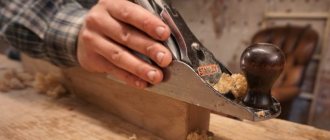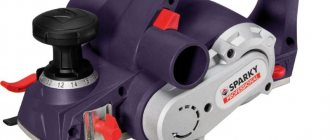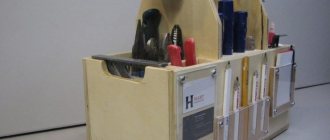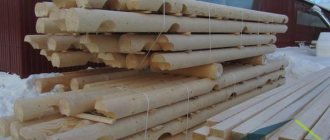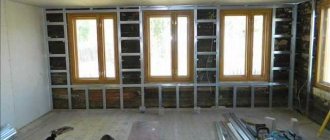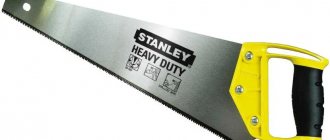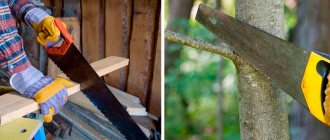How to sharpen a hacksaw yourself
A hacksaw for wood is one of the “eternal” values.
But, in order for a hand saw to always perform its functions, it must be sharpened correctly.
This is where basic knowledge about the type of cutting edge and its features will come in handy.
Of the existing methods, we will consider the safest and most popular ones, using available tools and available for home use.
Classification
Hand saws for wood come in a variety of configurations. Hence there are a large number of different models. The following types of hand saws are distinguished:
- classical. This type is the main one and almost every man has it. Such a saw can have a blade of different lengths with a different number of teeth. Most often, the tool has replaceable blades included in the kit upon purchase.
- narrow. This type of saw is also called a circular saw. It is named so because it helps to cut lines of various shapes, and very neat and clear ones. In addition, it is used to create through round and square holes. The file is quite narrow, has a large number of teeth, which can be located either on one working plane or on two. When working with such a saw you need to be careful. An uncertain movement can turn the blade in the other direction, for this reason, when choosing a hacksaw with a narrow blade, you need to choose high-quality hard steel that will not bend during operation
- with a butt. This hacksaw has a stiffening rib (shank), which does not allow the blade to bend during the cutting process. Consequently, the tool will not be able to make a cut below the width of the working part of the saw. This tool has a comfortable handle at an angle of 450 to the blade. This saw is easy to work with
- onion. In plumbing, a bow saw is an indispensable assistant. It is necessary in the process of cutting rough parts of the trunk, knots, as well as for cutting shapes from plywood and other wood materials. It can also be used to cut wood along and across the grain. The scope of use of a bow saw is so wide that it can become a substitute for a small woodworking machine. However, do not forget that the blade may fly off the mount or break during cutting.
- reward. A saw with an award will require a lot of effort from the master. This tool is similar to a plane. It has two handles. This saw is used for cutting grooves and tenons, and the depth of the holes and recesses can be made of different sizes. It can be used for rocks of any hardness
- folding. You can take this mechanical hacksaw with you on a hike or on vacation. Its main advantages: compactness, lightness, safety when folded. It has fine teeth and a short, pointed blade.
Why sharpen and when?
With constant use, the teeth lose their sharpness, the cutting edges wear out, deteriorating the quality of the cut and increasing the time it takes to complete the task.
Buying a new one will not correct the situation for long, and it will take no more than half an hour to restore the old canvas.
Timely sharpening of the hacksaw will restore the cutting ability of the incisors, and will always allow you to have a working tool at hand.
It is worth correcting the sharpness of the cutting edges at the first signs of wear, which can affect local areas and the entire working surface.
The dimensions of the cutter set also change, and this leads to jamming during operation.
Goats for firewood: drawings of devices for the most convenient cutting (80 photos)
Preparation of firewood for the winter is familiar to almost every rural resident and land owner. And of course, for convenient sawing of firewood you need a special tool called a sawhorse. Surely many have seen photos of sawhorses for firewood in magazines or on the Internet. This is not a complicated device that you can build with your own hands, and besides, it should certainly be in the household. With their help, it is convenient to process wood, wooden blocks or metal profiles.
Solving the question of what to make a goat out of at the dacha is quite easy. Indeed, to make this simple traditional design, it is enough to use the following materials:
- a wooden beam of a regular shape. Assembling a device from this material is simple, but it is susceptible to high humidity.
- wooden posts of medium diameter, which are used to build fences. This method is financially economical, but do not count on its reliability.
- metal strips that will ensure the reliability of the structure and will serve for many years.
- various items sent for scrap.
Although the sawmill for sawing wood has a simple design, it is essentially a machine. Therefore, in the process of its manufacture it is necessary to take into account some nuances:
- it is necessary to have a plan (drawing) of the future structure with step-by-step instructions and calculation of the dimensions of all parts.
- It is important to correctly calculate the inclination of the supporting elements for ease of use.
By observing these nuances, you will get a reliable, stable and comfortable-to-use trestle design. In addition, due to its mobility, it can be installed anywhere.
When assembling, the main thing to consider is the size of the equipment, which depends on:
- human height,
- parameters of the future device,
- strength and size of the wood requiring processing.
Depending on this, the length of working time spent will be determined.
A device with a height of 90-110 cm is considered a win-win option. As a result, the person working behind it will not have to lean forward too much, and the hands will not get too tired due to the horizontal position.
There will be minimal stress on the spine, and the work process will become much easier.
How to determine when it’s time to sharpen a hacksaw?
How to determine when it's time to sharpen the teeth of the tool.
An experienced owner knows when and how to sharpen a hacksaw, but it is not difficult for the average person to determine this point on their own. As a rule, the sound produced during operation and the uniformity of the color of the cutting edge change.
Sharp cutters are characterized by uniform wear of the cutting edge.
The following signs indicate the need to “correct” the saw:
• sawing is difficult and uneven; • the cut is uneven; • the blade often gets stuck; • it becomes difficult to maintain a given trajectory.
In addition, a dull hacksaw often gets stuck and requires a lot of effort to complete the process.
How to sharpen?
The process of sharpening a two-handed saw is carried out in the same way as in the case of an ordinary hacksaw for wood. Only with this tool everything happens much easier due to the large cutting teeth, you just need to prepare correctly. For self-sharpening you will need:
- rectangular file;
- template for precise setting of teeth;
- homemade wooden vice.
Since the blade of a two-handed saw is long, it cannot be clamped in an ordinary metal vice. You will need to design this device yourself. To do this, you need to fasten the saw blade lengthwise between two boards, tie them tightly at the edges with a rope and install the resulting structure on legs. Then you should make sure that there are no protruding elements among the teeth; they should all have the same height. If any tooth rises above the rest, you need to shorten its top with a file
It is important to maintain the length of the tooth relative to the base, so after grinding off the upper part, you need to make a corresponding cut deep into the blade
When sharpening, it is recommended to attach the file to a wooden block to avoid damaging your hands, and to carry out all work while wearing construction gloves. When the height of all the teeth is adjusted, you can proceed to setting them - bending the teeth in different directions one by one (one to the left, one to the right). This will increase the width of the future cut and make the work easier.
The template is a wooden or metal strip bent at a certain angle. Its flat base is applied to the saw blade, and the curved top determines the angle of the teeth.
After wiring, they begin directly to sharpening the cutting elements. To do this, a file is brought to the edge of each tooth and, using reciprocating movements, its edge is sharpened, like an ordinary kitchen knife. It is advisable to move the file away from you, this will create a sharper angle. When sharpening, you need to firmly press the surface of the file against the edge of the tooth; you cannot perform this action in a sweeping manner. Otherwise, the file may slip, which can result in serious hand injuries.
Having sharpened the edges on one side, you need to move to the other side and process the second edge of each tooth in the same way.
It is important to note that when purchasing a new tool, the width of the cutting edges on the teeth is different - one is narrower, the other is wider. Narrow edges only separate the fibers of the wood material, while wide ones cut them, which ensures fast and accurate cutting along the intended line. It is advisable to maintain these proportions during sharpening so as not to reduce the effectiveness of the tool.
It is advisable to maintain these proportions during sharpening so as not to reduce the effectiveness of the tool.
How to sharpen a hacksaw with your own hands
How to sharpen a hacksaw yourself if the need arises?
First you need to decide what material the work cloth is made of.
Ordinary steel can be corrected independently, but teeth with pobeditovy tips can only be processed on specialized industrial machines.
Some craftsmen, at their own peril and risk, undertake to sharpen a hacksaw using a grinder - but this is an unreliable and dangerous method.
To tidy up an ordinary manual hacksaw for wood at home, you will need to determine the shape of the teeth, prepare everything you need, and be sure to follow safety precautions.
An easy way to sharpen a circular saw blade
Hello, dear readers and DIYers! In this article, the author of the YouTube channel “GRINwood” will tell you how you can sharpen a saw blade for wood with carbide tips (for a circular saw) yourself.
The most interesting thing is that the capabilities of the circular saw itself will be used to sharpen the disc. Materials. — Maple lumber — Sheet plywood — Countersunk screw, washers — Wing nuts.
Tools used by the author. — Diamond grinding discs 150 mm, 150/180/240/320 grit — Circular saw, wood saw blade — Screwdriver — Countersink drill — Clamps — Marker, ruler, pencil, wrenches. Manufacturing process. Over time, the saw blade becomes dull and begins to leave marks on the workpiece. The author clearly demonstrates this by temporarily stopping the workpiece for a split second while making a cut.
On the front side of the jig he marked a line coaxial with which the sharpening disc should be located. The hole to which the saw blade will be attached is shifted to the side. This will give you the required angle of 15 degrees.
The disc is secured to the jig using a bushing, washer and wing nut.
The master sets the stop so that the plane of the sharpening disk and the tooth coincide.
Now you can turn on the engine. The edge of the sharpening disk is brought to the solder, and the saw blade is smoothly turned counterclockwise. This is how all the “left” teeth are sharpened.
The master repeats the processing of the workpiece exactly, stopping it periodically. Even with a delay of a second or more, no marks were formed, and the surface of the workpiece was almost perfect.
Good mood, good luck, and interesting ideas to everyone!
The author's video can be found here. Source
General requirements for sharpening
Not every garage or workshop has a special machine for sharpening hacksaws, but it won’t hurt to sharpen the tool yourself.
There are, of course, exceptions - hardened teeth cannot be sharpened.
Diamond drills and other tricks will not help.
This saw has an increased service life and must not be repaired, but replaced with a new one.
It is easy to identify hardened steel - it is distinguished by its black color with a blue tint.
A grinder or a file and a needle file are usually used as a sharpener for a hacksaw.
A prerequisite is to first carry out the correct setting of the teeth, because the thickness of the hacksaw blade affects the width of the cut, so the edges must be bent to the required width.
Briefly about the main thing
To sharpen a saw intended for sawing wood, it is first clamped in a vice. Then the teeth are set. Then they are leveled in height. Next, take a triangular file and sharpen the prepared teeth with it, first on one and then on the other side of the hacksaw.
When using a grinder, the saw is secured with clamps on a stationary surface. The plane of its canvas should be horizontal relative to the ground. In this case, a disk with a minimum thickness is installed on the grinder. They sharpen saw teeth at an angle of 15-30°.
To cut wood, a classic saw is often used. There are also reward, round, plywood, trigger, two-handled, and axed hacksaws for wood. Each of them consists of a canvas and at least one handle.
Necessary tool
Sharpening a hacksaw using a grinder or grinder requires certain skills.
It is much safer and easier to sharpen a hacksaw mechanically.
Before you begin, prepare a vice or clamp, calipers, hammer and other necessary tools:
Crosscut saws are sharpened at an angle of 60 degrees using a triangular fine file.
Longitudinal with an angle of less than 60 degrees - use a large needle file or diamond file with fine abrasive.
For a mixed type, you will need a coarsely cut file or a finely cut diamond file.
For this operation, a special sharpening device is useful - a wooden block with a cut-out socket to protect your hands from cuts.
NOTE:
To sharpen a hacksaw using a grinder, you will need a cutting wheel with a thickness of 1.2 to 1.4 mm, with a diameter of 115 or 125 mm. The angle grinder must have a speed adjustment in the range of 5000 - 8000 per minute. Installing protection is a prerequisite for using this method. As a rule, a homemade shield made of transparent plastic is used.
Wood saw sharpening technology
Proper sharpening of a hacksaw should preserve the working profile of the teeth.
It is determined by the following parameters:
• pitch and height; • point angle; • radius of curvature.
The sharpening angle can be set in the range from 30 to 60 degrees, and depends on the material.
So, for soft wood, 50 degrees will be optimal.
It is important to secure the blade correctly in the vice - do not clamp it too hard, as the steel will vibrate under the file.
Using a workbench and a clamp, you can conveniently secure the hacksaw.
Sharpening is done by alternating double-sided sharpening - first, one row is passed along the left edges of all teeth.
Then the tool is turned over and the passage along the right half of the cutters is repeated.
The one-way method is not used for straightening hand saws - it is applicable only to certain types of knives.
My folding saw "from what was"
I, like many of you, have various Soviet tools, and I usually don’t throw away various pieces, trimmings and remnants of building materials - maybe they will come in handy.
And this is what I used from my supplies.
Materials:
- Blade from a “Soviet” hacksaw
- A small piece of plywood, 10 mm thick
- A piece of plastic, 5 mm thick
- Bolts (with nuts) M5 – 4 pcs.
- Bolt for clamp M5, 12 mm – 1 pc.
- A piece of a metal ruler, 40 mm long
- Nylon lids for cans – 2 pcs.
- Wood varnish
Tools:
- Bulgarian
- Jigsaw
- Drill
- Sandpaper (40)
- Piece of block
- Brush
How to properly sharpen a hacksaw with a file
Using a file is still relevant today, so let’s try to figure out how to properly sharpen a hacksaw at home.
Let's start by installing the canvas.
It must be secured, as already mentioned above, in a clamp or vice.
The jaws of the vice must be made of wood, with the width of the “jaws” not less than 200 mm.
The movement of the file should be uniform, and pressure on the teeth should only be applied when moving “forward”.
It is necessary to move the hand with the tool to the starting point freely, without force on the incisors.
In one working pass, a uniform layer of metal is removed, this will preserve the pitch, height and profile of the edge.
The sharpness of the cutter can be reduced due to the formation of burrs on the surface and irregularities after passing the abrasive.
A file cannot sharpen a hacksaw perfectly, but you can get high quality - after sharpening, the smallest file or needle file and whetstone will come in handy.
Burrs are removed by selective grinding with a fine abrasive, and the edges are leveled with a wet whetstone along the side base of the blade.
When you set out to sharpen a hacksaw correctly, pay attention to maintaining the tops of the teeth.
The same height of the cutters and correct setting affect the wear resistance of the tool and the quality of the cut.
How to check if your saw is sharpened correctly
After finishing the process of sharpening a tool for working with wood, it is worth checking each tooth of the hacksaw against the light. If shine is visible, the sharpening was done correctly; if not, then you should go over the “suspicious” teeth again. You should also check whether the teeth on the blade are the same height. If they are higher or lower, this will lead to lower cutting quality and blade wear will be unevenly distributed.
Is the saw sharpened correctly?
As a result, when sharpening a hacksaw blade, you need to adhere to the following recommendations:
- The blade must be securely secured in a vice without the slightest sign of slipping during the process.
- The workplace should be as illuminated as possible; this will not only allow you to work normally with the tool, but will also protect your eyes from wearing glasses prematurely.
- The depth of the cut of the selected file depends only on the degree of dullness of the teeth - the duller, the more “powerful” the tool is needed.
- Sharpening of metal occurs only when moving away from you and only in one direction. This prevents hand injuries from accidentally touching the canvas during movement.
- After finishing sharpening, it is necessary to check the quality of the work performed, and in case of unevenness, it is better to correct it immediately than to suffer later in the process of sawing wood, especially hardwood.
On a note. When using a hacksaw, you should regularly pay attention to its performance. This will save effort, nerves and the tool will last a very long time if handled with care.
Any tool should be checked before and after completion of work. Safety first! If with a hand tool there will only be a cut at best, then with an electric one it can result in a lifelong injury. Therefore, it is recommended to inspect the instruments before use.
All the recommendations and warnings will help you properly sharpen any hand saw for working with wood, and you won’t have any problems determining when to do it.
voice
Article rating
Hacksaw teeth set
The movement of the blade must be free, for which the saw teeth are set apart by the same amount.
To reduce the coefficient of friction and the clamping of the hacksaw in the cut, its width must be greater than the thickness of the working blade, otherwise the metal heats up and expands, which leads to the saw jamming.
The teeth of the hacksaw are set by bending the cutters to the sides.
Using pliers does not allow you to obtain the same angle of inclination - with such a tool you can only cut firewood.
To spread the cutters evenly and get an even, neat cut, use a homemade device for setting the teeth.
To make it, you need a metal die of arbitrary shape with a thickness of 2-3 mm.
In a simple version, several slits are made to indicate the thickness of the canvas.
The tooth is grabbed into the hole and bent until the selected stop is reached.
In the second version, a cut is cut into the plank with a metal file, and two holes are drilled to install the limiter.
Rotating the sector to the sides allows you to adjust the bend angle.
The figure shows a simple model and wiring with a stop.
The design of the device is intuitively easy to manufacture and use.
It is necessary to take into account that the width of the bend has its own parameters.
Requirements for the setting of hacksaw teeth
When bending the cutters one at a time on both sides of the canvas, maintain a certain value that can be set on a homemade device.
The width of the wiring depends on the type of wood.
Soft and damp wood requires a larger angle of inclination than dry wood.
As a rule, hand tools work effectively with an average value of 0.2-0.3 mm.
At the same time, the total value should not exceed the width of the canvas.
In addition, the same nature of the bend on each side is observed.
The wiring for the hacksaw is checked visually or using a caliper.
Pay attention to the size of the tooth - the height of the incisor is especially important.
Video description
The process of sharpening a hacksaw with a grinder is shown in the video:
The operation of restoring a hand saw using an angle grinder is a more painstaking job than sharpening a chainsaw. However, the process is still not too difficult, but only an experienced master can carry it out efficiently.
Using a grinder allows you to reduce sharpening time by almost half compared to using a file. After all, with a hand tool you need to perform synchronous movements and constantly control the amount of material removed from each tooth.
Leveling the height of the links
All teeth must be the same height.
An uneven edge results in uneven loading and significantly reduces work efficiency.
Checking the height of the hacksaw teeth
It is necessary to check the height of the teeth before sharpening the tool.
To do this, place a sheet of plain paper on a hard and flat surface, and press the cutters tightly until a clear imprint is obtained.
If there are teeth protruding from the general row, traces of them will be reflected on the print.
If there are higher teeth, they are carefully cut down with a flat file to the general level.
Saw layout
When retracting the saw, one should not forget about the uniform bending of all teeth at the same angle, so that there is no increase in resistance to broaching and high wear of the metal. You need to start bending the teeth from the middle. If you try to bend them at the very base, you can damage the blade. The teeth deviate from the blade after one, that is, every even tooth to the left, every odd tooth to the right. Only an experienced carpenter can determine the layout visually and without the use of tools. Such skills come only after spreading the teeth of many dozens of hacksaws.
In the absence of such experience, a special tool comes to the rescue. The most affordable option is a regular flat steel plate. A slot is made in it, into which the hacksaw blade should fit almost without a gap. The wiring process is performed as follows:
- the hacksaw is clamped so that the teeth are slightly visible above the clamp;
- each tooth is clamped by a setting groove and bent towards the middle;
- the angle of spread must be constantly monitored;
- each even tooth in a row bends to the left, then each odd tooth bends to the right or in the reverse order.
With different tooth heights, sawing wood will not be effective, since teeth of higher height will wear out more due to greater load, and teeth of lower height will not take part in the work at all. The broaches of the canvas will be uneven and twitchy. There will also be complaints about the accuracy of sawing and the quality of cut surfaces. It is necessary to align the teeth in height before sharpening. The height is checked as follows:
- the teeth are pressed against the paper, which lies on a flat surface;
- the canvas is imprinted on it;
- The height of the teeth is determined from the profile of the impression.
To align teeth with differences in height, the blade must be clamped in a bench vice and the excess metal must be ground off. If the teeth have a large difference in height, you need to select the average value and try to align as many of them as possible to it.

